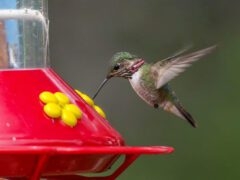Bananaquit Photo Gallery
Adult (Continental)
A small songbird with a curved, pointed bill; pinkish gape; bold white line above the eye; yellow underparts; and dark upperparts. The widespread “Continental” subspecies group, found from Mexico to Argentina, has a grayish throat, but some Caribbean subspecies groups have a black or whitish throat.
© Marcos Eugênio Birding Guide / Macaulay LibrarySão Paulo, October 27, 2014Adult (Puerto Rico)
The “Puerto Rico” subspecies group has a dark gray throat, blackish back, and prominent white wing patch (present in some other subspecies groups and absent in others).
© Michael Stubblefield / Macaulay LibraryUtuado, February 18, 2019Adult (Continental)
A small, fidgety songbird with a curved, pointed bill; yellow underparts; dark upperparts; and a strong white stripe above the eye. Throat color (white, gray, or black), upperpart color (gray to black), and presence of white wing spot varies between subspecies groups.
© Greg Baker / Macaulay LibraryPichincha, June 03, 2016Not all videos have soundAdult (Bahamas)
The “Bahamas” group has a whitish throat and upper breast.
© Brian Sullivan / Macaulay LibrarySouth Abaco and Moore's Island, November 25, 2006Adult dark morph (Grenada)
The “Grenada” subspecies group includes individuals that are nearly all-black as well as more typically plumaged birds with a yellow breast and white eyestripe.
© Alan Van Norman / Macaulay LibrarySaint George, March 14, 2015Adult (Continental)
Feeds mainly on nectar, using the sharp, curved bill to reach into flowers or pierce them at the base.
© Arthur Gomes / Macaulay LibrarySão Paulo, May 21, 2020Not all videos have soundJuvenile
Juvenile has a yellowish eyestripe, limited pale yellow on the underparts, and drab upperparts.
© Michiel Oversteegen / Macaulay LibraryAruba, November 07, 2016Adult (Continental)
Feeds primarily on the nectar of flowering plants.
© Róger Rodríguez Bravo / Macaulay LibraryPuntarenas, July 08, 2013Adult (Greater Antillean)
Builds messy, globe-shaped nests, both for breeding and to serve as “dormitory nests” for roosting birds.
© Justin Proctor / Macaulay LibraryLa Vega, June 04, 2014Not all videos have soundAdult (Greater Antillean)
Often occurs in pairs or small family groups. Note the yellow rump, found on all subspecies groups.
© Jay McGowan / Macaulay LibrarySaint Andrew, March 22, 2023Not all videos have soundDon't miss a thing! Join our email list
The Cornell Lab will send you updates about birds,
birding, and opportunities to help bird conservation.










